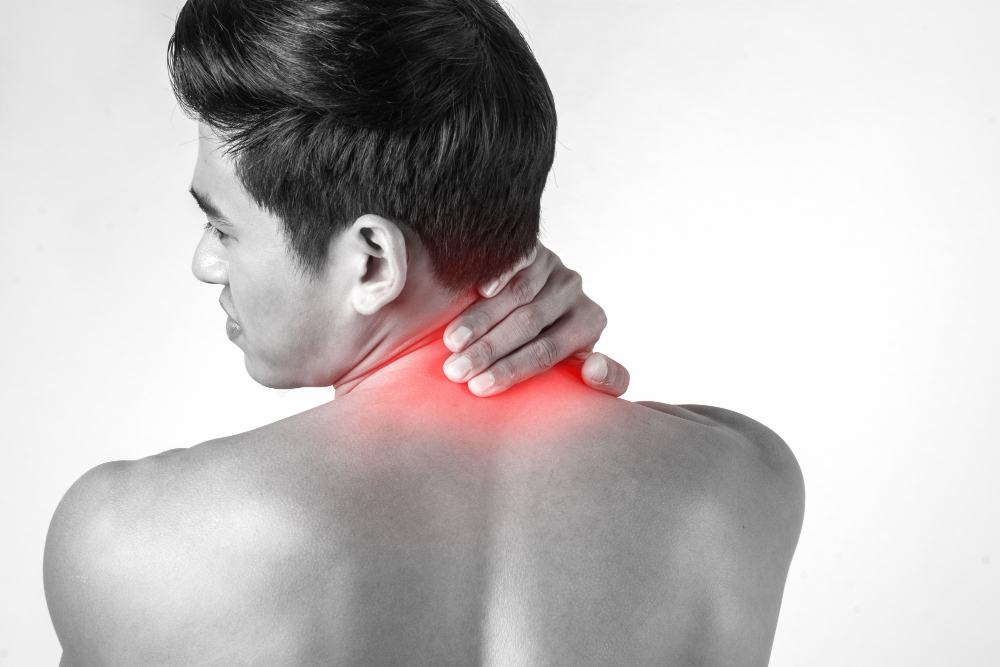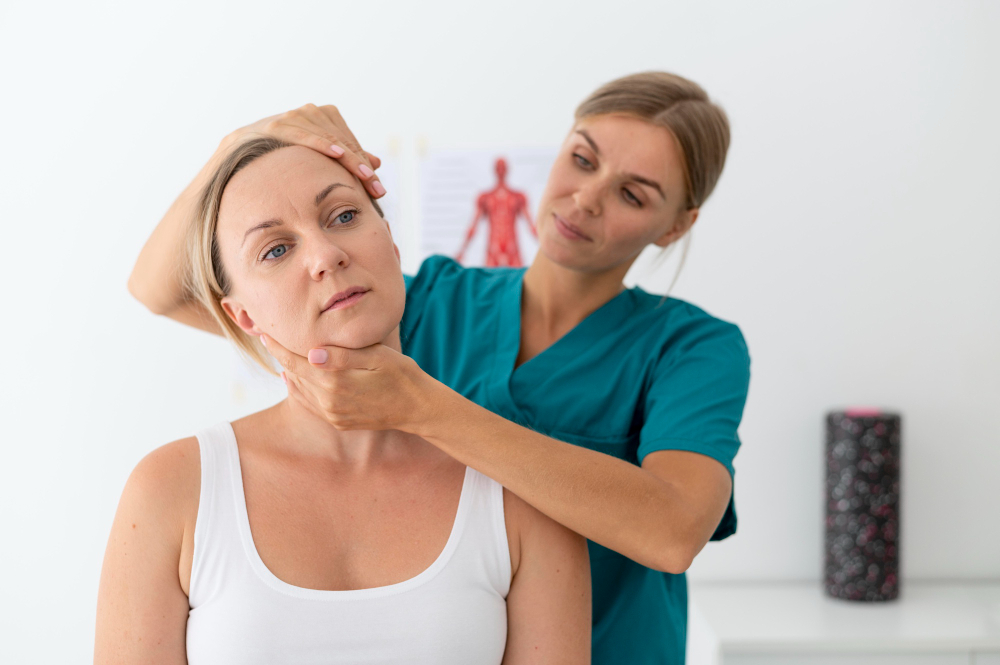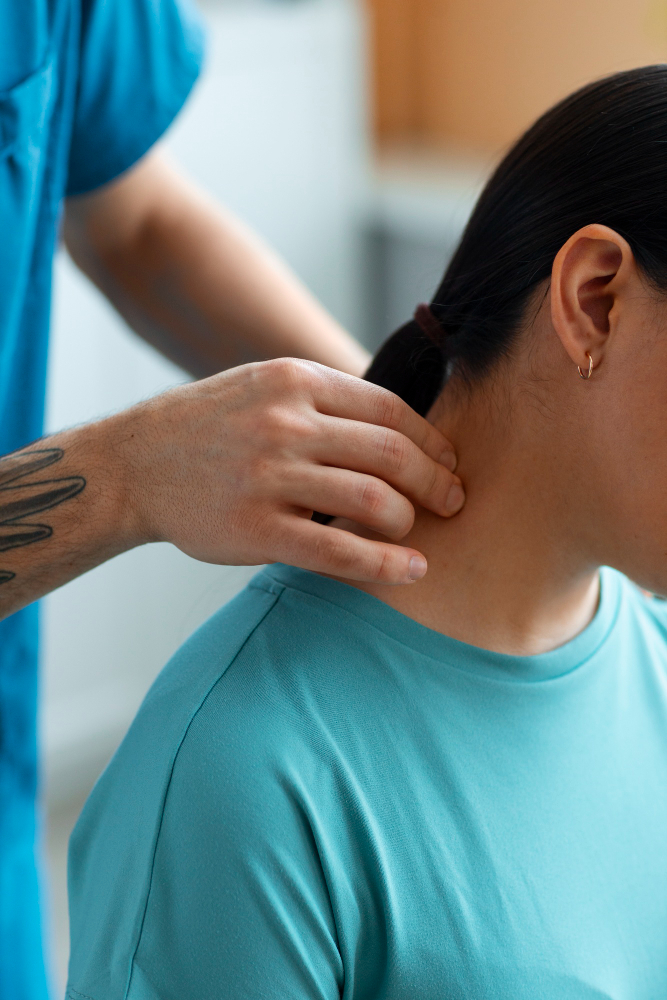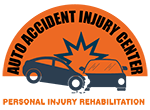Neck Pain Treatment

What is Neck Pain?
The neck acts as the bridge between the head and your torso. The neck supports the head weight and allows it to turn and move in almost all directions. Also referred to as the cervical spine, the neck is a collection of 7 vertebrae, numerous muscles, nerves, and ligaments coordinated by the spinal cord and brain. While the neck is responsible for moving your head in nearly all directions, the flexibility makes it susceptible to pain.
Neck pain refers to any stiffness, soreness, or pain in the neck region. The pain may also radiate down into your shoulders, hands, and fingers. It can be deliberating and may interfere with our day-to-day activities. Unfortunately, this pain is joint, and almost 10-15 percent of individuals globally have neck pain at any given time. Today, neck pain is the fourth leading cause of disability globally.
Contrary to what you may think, neck pain does not always occur in the cervical vertebrae region. It can also radiate across your upper body, leading to discomforts in your shoulders, chest, and arms. The discomfort also leads to severe headaches, making it hard to concentrate and get through the day. Even worse, studies show that neck pain affects more than just the physical body. Research shows that chronic pain usually leads to depression and other mental illnesses.
While the pain may go away after a few days, chronic pain is usually an indication that not everything is well. If left unattended, the pain can worsen over time. At the T98 chiropractic and rehab center, we recommend coming in for assessment and treatment as early as possible.
Common Neck Pain Signs and Symptoms

In most scenarios, neck pain develops immediately following an injury or a delayed reaction to an injury. It can also develop gradually over time or starts suddenly without any preceding symptoms whatsoever. Generally, neck pain symptoms vary from one patient to the other. The symptoms depend mainly on the injured part of the cervical spine. T98 chiropractors treat each case differently. These professionals scrutinize your neck to find the underlying causes of the neck pain. The detailed examination helps the chiropractor to come up with a customized treatment plan that fits your needs. Neck pain usually involves one or several of these signs and symptoms.

- Stiff Neck
The most common sign of neck pain is a stiff neck. You may feel a sore neck and face difficulties when you try to turn your head from side to side. - Sharp Pain
You may also feel a stabbing or stinging pain that occurs in one spot. The pain usually occurs in the lower neck part. - Radicular Pain
Neck pain is not only localized on the cervical spine only. It can also radiate along the nerves from the neck into the shoulder, arm, and chest area. The intensity will vary from one person to another, and it may feel like it is searing or burning. - General Soreness
You may also feel general discomfort in the neck or the regions surrounding the neck. Your neck may feel achy or tender. The pain is not as sharp as that you will find in the lower neck part. - Cervical Radiculopathy
Nerve root compression occurs when there are neurological deficits. Neurological shortfalls lead to sensation, reflexes, and strength problems in your arms and shoulders. The conditions may also involve radicular pain that radiates down to your arms or up to your head.

Associated Neck Pain Symptoms
As mentioned earlier, neck pain can also develop over time. The condition may lead to some symptoms that start as mild, which you can easily ignore. However, as time goes by, these symptoms may become severe. Here are some of the associated symptoms that you may experience when you are suffering from neck pain.
Trouble Lifting or Gripping Objects
The radiating pain may cause numbness or weakness in your arms or fingers. Weak muscles make it hard for you to grip or lift objects.
Headaches
The irritation in your neck may also affect your nerves and muscles connected to your head. This irritation can cause various types of headaches, including cariogenic headache, occipital neuralgia, and tension headache.
Problems with Balance and Coordination
Neck pain can be deliberating that you may avoid turning your head in a particular position. Reduced range of motion makes it hard to perform your daily chores. In some instances, you may need to turn your body as a whole when you want to have a glance at something.
When the pain symptoms progress, you may start having trouble when sleeping. The pain may also interfere with your daily activities, especially those involving turning the head, such as driving. You may experience one or several of these symptoms. When you do, you need to book an appointment with our clinic. Our experienced chiropractors will do a detailed examination and address the underlying causes, helping you recover much faster.
What Are Common Neck Pain Causes?

Neck pain is a common ailment. Sometimes, the pain usually indicates overuse of the muscles in your neck. However, in other times, the pain is usually an indication of a much serious problem. Generally, the pain tends to increase in middle age and usually dominates slightly more in women than men. The pain is also more familiar with a sedentary lifestyle, smokers, and patients with a family with a neck pain history.
Although pain is usually joint in individuals over 50 years, there are various causes of neck pain. Speaking of the common causes, here is a list of the various causes of neck pain in both the young and the old.
Injuries and Accidents
- Whiplash Injury:
Whiplash is a common neck injury, usually sustained when there is an immediate impact that forces the head to move forward or backward forcefully, beyond the normal motion range. The impact causes rapid movement, which injures the ligaments and muscles. The impact also causes muscle fatigue that leads to stiffness and pain. Most often, whiplash is sustained during an auto accident injury , although it can also result from other traumas such as sports accidents or falls. - Nerve Compression:
When the cervical nerves become compressed or irritated, it can also cause a radiating pain that usually moves up into your head. The pain may also radiate downwards into your shoulders, chest, arms, and fingers. The most common cause of nerve compression is the herniated disc and crowding of the spinal canal.
Health Conditions
- Osteoarthritis:
Osteoarthritis, also referred to as spondylosis when it affects the spinal joint- is a common arthritis form. It is caused by aging and tissue wear and tear. Spondylosis creates bone spurs that crowd the spinal canal, compressing the neck’s nerve roots when left untreated. - Other Arthritis Forms:
Many arthritis forms, precisely the inflammatory types, are also responsible for neck injuries. The inflammatory arthritis types include rheumatoid arthritis, psoriatic arthritis, rheumatoid arthritis, and ankylosing spondylitis. Chronic inflammation in the cervical spine damages the joints that are responsible for the neck’s movement. - Other Disease Conditions:
While the leading cause of neck pain is prolonged strain and neurologic deficit, neck pain can also indicate a more severe condition. In most cases, if you have sustained a head or back injury, your cervical spine is also likely to be affected. Some of the conditions that may indicate an underlying condition include spinal infection, tumor, spinal cord compression, and fracture.
Lifestyle Issues
- Stress:
It is hard to live a stress-free life, especially with our busy schedules and tight deadlines to keep. Stress is a significant cause of neck pain. It clenches the muscles that support free neck movement, potentially leading to a sore, stiff neck. - Overweight/Obesity:
Extra weight puts undue stress on the cervical spine. The weak abdominal muscles may not be able to support the extra pounds. Excess weight may disrupt the balance on the spine, forcing the neck to bend forward. The weight puts much pressure on the muscles, leading to a sore, painful neck. - Poor Posture:
The prolonged low structure is another leading cause of neck pain. In most cases, it happens when your head is tilted forward for long hours, leading to overuse of the neck’s muscles, ligaments, and tendons. Sitting at a computer, reading in bed, gardening, and texting on your phone can lead to neck pain.Using a poorly lifted pillow and sleeping in the wrong position also leads to a sore neck. The awkward sleeping position creates fatigue in the spinal joints and muscles
How Can It be Diagnosed and Treated?
At T98 chiropractor clinic, we diagnose neck pain by taking a comprehensive patient’s medical history. The chiropractor will ask you to describe your neck pain in detail. The professional will also discuss various factors such as your lifestyle, occupation, injuries, and sleep habits to understand your condition better.
The professional will also conduct a physical examination, which involves assessing your range of motion, muscle strength, and reflexes. Diagnostic imaging may also be necessary for neck pain diagnosis and treatment. Neck pain treatment is usually dependent on the results of a thorough examination.


Chiropractic Treatments for Neck Pain

At T98 Rehab, our chiropractors help treat neck pain using different techniques like spinal manipulation and manual therapy. They make a unique treatment plan for each patient based on what’s causing the pain.
Here are some of the common ways chiropractors treat neck pain. The actual treatment will depend on what the chiropractor finds. They’ll explain all your options clearly to meet your specific needs. Here are some methods chiropractors use to help your neck feel better:
- Flexion Distraction Technique: This technique is a gentle way to adjust the spine. The chiropractor uses their hands to gently pump the area around the discs in your spine, which helps them heal faster.
- Specific Spinal Manipulation: This method involves gently pushing on a specific joint in your spine to help it move better.
- Instrument-Assisted Technique: In this method, the chiropractor uses a small tool to apply gentle pressure to the affected area without pushing directly on the spine.
- Manual Joint Stretching: Also referred to as resistance techniques, manual joint stretching also helps minimize neck soreness and pain.
- Trigger Point Therapy: The technique helps to relieve painful joints and relax the tight muscles.
Some of the other therapies that help in easing pain symptoms include:
- Inferential Electrical Stimulation: Sore muscles limit blood circulation. Inferential electrical stimulation uses a low-frequency electrical current to stimulate and relax the muscles. The stimulation ensures that the tissues receive enough oxygen and ingredients needed for a. speedy recovery.
- Manual Therapy: The chiropractor also uses manual therapies in treating your sore, painful neck. These techniques help treat the muscle tension caused by inflation, stress, and wear and tear. These therapies include:
- Therapeutic Massage: Therapeutic massage helps to relax a tense muscle. The technique will also promote blood circulation to the affected area, promoting faster healing.
How Can Chiropractic Care Help Those with Neck Pain?
Chiropractic care is an excellent way to relieve and manage the discomforts associated with neck pain. Our chiropractors provide the patient with a safe, medication-free, and noninvasive specialized treatment. Unlike addictive pain medications, our chiropractor creates a personalized treatment plan to suit your needs. Overall, our routine chiropractic care is cheaper than undergoing surgeries.
You do not need a lot of time healing surgery scars. Our treatment plans are all-natural, helping you get back on your feet in no time. Chiropractic adjustments help in improving the affected muscles and nervous system. Increasing the blood circulation and reducing inflammation will give your body a better chance of managing the neck pain discomfort. Visiting our clinic will provide the patient with neck pain with the following benefits.
- Reduced pain and discomfort
- Better range of motion
- Increased flexibility
- Reduced inflammation
- Increased activity and lifestyle

Why T98 Rehab Chiropractic and Wellness for Your Neck Pain?

